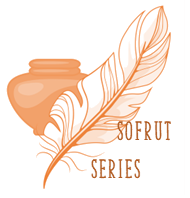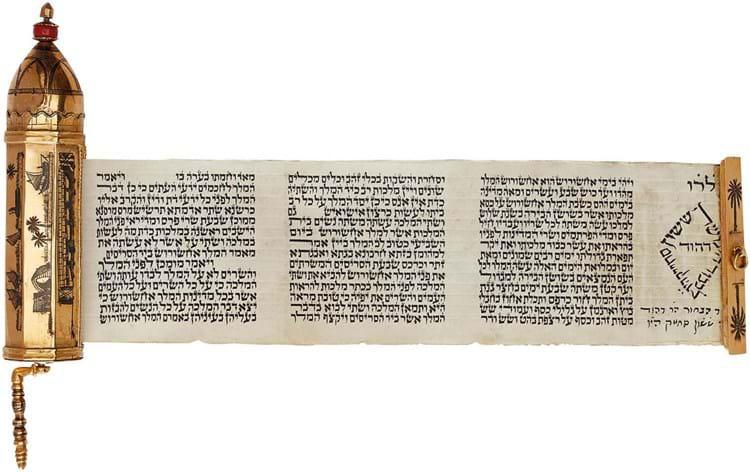
Megillot Esther (Esther scrolls) can vary widely from one tradition to the next. Line counts can range from 8 to 42, for instance – generally 8, 11, 14, 21, 28, 42 or 48. The latter two are most commonly used for synagogue readings, since they are similar in height to that of a Sefer Torah and require less rolling during the reading than a smaller scroll. Megillot Esther, like Sifrei Torah, must must be handwritten, and is never be written from memory.
(ט) אֵין כּוֹתְבִין הַמְּגִלָּה אֶלָּא בִּדְיוֹ עַל הַגְּוִיל אוֹ עַל הַקְּלָף כְּסֵפֶר תּוֹרָה. וְאִם כְּתָבָהּ בְּמֵי עַפְּצָא וְקַנְקַנְתּוֹם כְּשֵׁרָה. כְּתָבָהּ בִּשְׁאָר מִינֵי צִבְעוֹנִין פְּסוּלָה. וּצְרִיכָה שִׂרְטוּט כַּתּוֹרָה עַצְמָהּ. וְאֵין הָעוֹר שֶׁלָּהּ צָרִיךְ לְעַבֵּד לִשְׁמָהּ. הָיְתָה כְּתוּבָה עַל הַנְּיָר אוֹ עַל עוֹר שֶׁאֵינוֹ מְעֻבָּד אוֹ שֶׁכְּתָבָהּ עַכּוּ''ם אוֹ אֶפִּיקוֹרוֹס פְּסוּלָה:
(9) We may only write a Scroll with ink on a hide or on a parchment, like a Torah [scroll]. But if one wrote it with gallnut extract and iron sulfate, it is [also] fit. If he wrote it with other types of dyes, it is disqualified. And it requires scoring like a Torah itself. But its leather does not require processing for the sake of [the commandment. If] it was written on paper or on hide that was not processed or was written by an idolater or a heretic, it is disqualified.
While there is much more room for creativity in a megillah than in a Sefer Torah, there is a distinct prohibition against writing the names of Hashem in gold ink/paint.
(קעו) וכאשר באו בידיהם המתנות אשר נשלחו והדפתראות המצוינים אשר הייתה בהם התורה כתובה בזהב באותיות היהודים והקלף היה מעובד להפליא והתפר של [היריעות] זו לזו לא היה נראה כראות המלך את האנשים התחיל שואל על הספרים:
(176) When they entered with the gifts which had been sent with them and the valuable parchments, on which the law was inscribed in gold in Jewish characters, for the parchment was wonderfully prepared and the connexion between the pages had been so effected as to be invisible, the king as soon as he saw them began to ask them about the books.
כְּפוּפִין פְּשׁוּטִין, פְּשׁוּטִין כְּפוּפִין. מֵימִין סָמְכִין, סָמְכִין מֵימִין. סְתוּמִין פְּתוּחִין, פְּתוּחִין סְתוּמִין. פָּרָשָׁה פְּתוּחָה לֹא יַעֲשֶׂנָּה סְתוּמָה, סְתוּמָה לֹא יַעֲשֶׂנָּה פְּתוּחָה. כְּתָבָהּ כְּשִׁירָה, אוֹ שֶׁכָּתַב אֶת הַשִּׁירָה כַּיּוֹצֵא בָהּ, אוֹ שֶׁכָּתַב שֶׁלֹּא בִּדְיוֹ, אוֹ שֶׁכָּתַב אֶת הָאַזְכָּרוֹת בְּזָהָב — הֲרֵי אֵלּוּ יִגָּנְזוּ.
Similarly, one should not write bent letters like kaf and nun found in the middle of a word as straight letters like kaf and nun found at the end of a word, nor should one write straight letters as bent letters. A final mem should not be written like a samekh, and a samekh should not be written like a mem. A closed mem should not be written open, and an open one should not be written closed. Similarly, if there is an open paragraph in the Torah one may not render it closed, and one may not render a closed paragraph open. If one wrote a mezuza or a Torah scroll following the Torah’s format for poetry or if one wrote poetry like regular text, as a mezuza is typically written, or if one wrote without ink but with another material, or if one wrote the mentions of God’s names in gold, all of these must be suppressed.
Illumination vs. Illustration
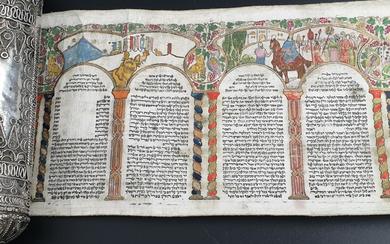
Generally speaking, the terms illumination and illustration, as pertaining to Hebrew manuscripts, are not interchangeable. Illustration refers to the practice of depicting scenes from the work in cameo images, whereas illumination refers to applying colored inks or paint to border art which is more thematic than illustrative. Nota bene: The Chofetz Chaim opines that though illumination is permissible, illustration is not (Mishnat Hasofer 28), but many 10th-18th century Megillot Esther – most often in Ashkenaz and Italian exemplars – contain both elements (in line with Shu”t Zerah Emet 1:100).
Illuminated manuscripts began to appear in Jewish society in the 10th century in the Middle East and around the 1230s in Iberia, France, the German Lands, and Italy.1 Note the image above depicts a megillah written according to the tradition of the Vilna Gaon (haGr''a), i.e. with no change in text size for the aseret b'nei Haman (10 sons of Haman) passage (Biur HaGr”a, Orach Chaim 691:25). Though it is presently en vogue to write megillot in 11 lines and call it "haGr''a," his own megillah was written with the list beginning at the head of a 48-line column in normal size script, completing the column with the subsequent text (as is the Chabad practice). Another method sometimes employed is to write in 21 lines with blank lines interspersed between the lines of aseret b'nei Haman.
(ו) מה שנוהגין הסופרים לכתוב עשרת בני המן באותיות גדולות אינו מעיקר הדין שהרי לא נמנו במסורה בין האלפ"א בית"א גדולים. אך הסופרים נהגו כן לפי שעל הרוב כותבין את המגילות על דפין ארוכין ועשרת בני המן אינן אלא י"א שיטין וצריכין למלאות בהן את כל הדף וישאר חלק הרבה לבסוף או ריוח גדול מאוד בין שיטה לשיטה לכן כותבין אותיות גדולות למלאות את הדף. ואעפ"י שבדף אחר אין לעשות אותיות גדולות או קטנות כשאינו מקובל מבעלי המסורה לעשותן שאני הכא כיון שעשרת בני המן כתובי' בדף מיוחד בפני עצמן אין להקפיד אף שהדפין האחרים כתובים בכתיבה דקה ודף זה בכתיבה גסה. ומ"מ אם אין יריעות המגיל' ארוכות ולא יושחת תואר העמוד כשיכתוב בכתיבה בינונית קרוב לכתב של שאר הדפין מוטב לכתוב כתיבה בינונית (שערי אפרים שער ו' סעי' נ"ה):
The custom of writing the ten sons of Haman in big letters is not fundamental, as there is not an authoritative tradition to this effect. They do it because people generally write the Megillah in long columns, but the ten sons occupy only eleven lines and must occupy the whole column, so either one must leave a long gap at the bottom, or must leave large spaces between the lines, and so they write in large letters to fill up the column. There is not a received tradition for using larger or smaller letters in the other columns, but even so, this is different, because the ten sons are written in a special column by themselves, so we shouldn’t be troubled if this column is in large letters and all the other columns are in small letters. Nevertheless, if the panels aren’t tall and the form of the column wouldn’t be adversely affected by his using an average-size script like in the other columns, it’s better to use average script (Sha'arei Ephraim, 6:55).
It is stated in Shemot 20 that graven images for the purpose of bowing down to worship them is forbidden, but where idolatry is not the intent, illustration or illumination is permitted – in some cases. Though it is never permissible to decorate a Sefer Torah in this manner, other texts can be so adorned, and doing so for Megillat Esther is a long-held tradition dating back to medieval times.
Scribal Embellishments
For as short as the Esther scroll is, it is packed full of visual midrash! It contains, in some traditions, as many as 23 enlarged (majuscule) letters and 3 suspended (minuscule) letters. Additionally, most modern megillot Esther are written in what is called "HaMelekh format."
The Two Gates
The first modified letter occurs in tandem with the last, forming a sort of inclusio (envelope) for the entire scroll. These two enlarged letters – the chet of חור in 1:6 and the tav of ותכתב in 9:29 – are both similar in appearance to the shape of a gate and have, in fact, been interpreted as representing "two gates." Having one at the front and one at the back symbolizes that Judaism opens wide both the front and back doors/gates so that all may be welcomed in – rich or poor, Jew or Gentile – to enter into the celebration of the Feast of Esther (Purim).2
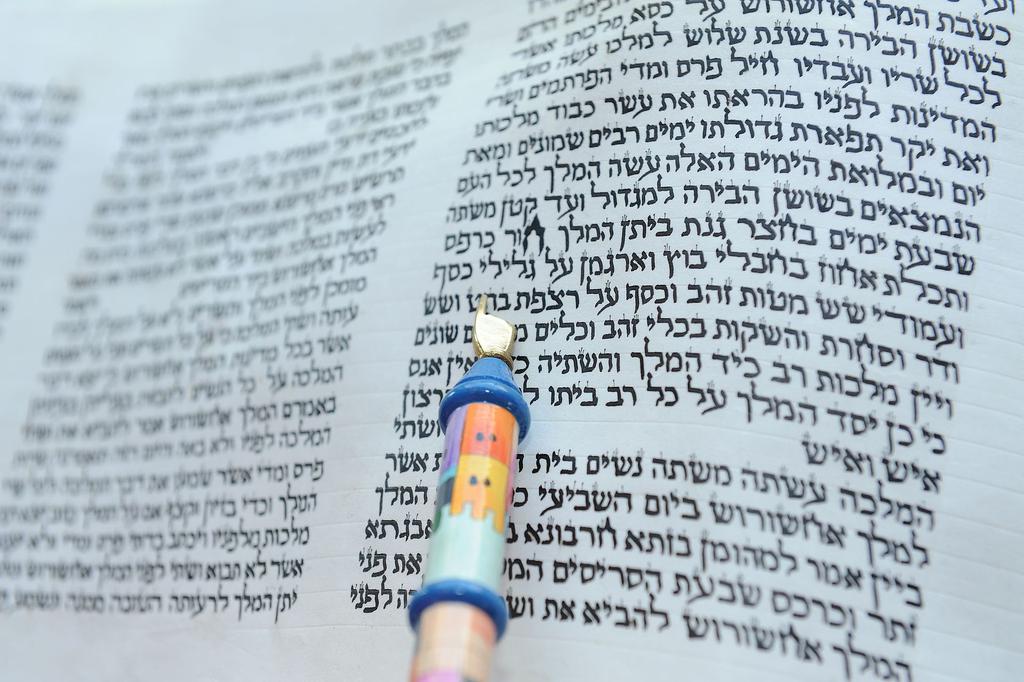
An additional explanation for the final enlarged letter of the megillah is alluded to in Yoma 29a, i.e. that Esther reflects the last of the recorded miracles in the Tanakh.

אָמַר רַבִּי זֵירָא: לָמָּה נִמְשְׁלָה אֶסְתֵּר לְאַיָּלָה — לוֹמַר לָךְ: מָה אַיָּלָה רַחְמָהּ צַר וַחֲבִיבָה עַל בַּעְלָהּ כׇּל שָׁעָה וְשָׁעָה כְּשָׁעָה רִאשׁוֹנָה, אַף אֶסְתֵּר הָיְתָה חֲבִיבָה עַל אֲחַשְׁוֵרוֹשׁ כׇּל שָׁעָה וְשָׁעָה כְּשָׁעָה רִאשׁוֹנָה. אָמַר רַבִּי אַסִּי: לָמָּה נִמְשְׁלָה אֶסְתֵּר לְשַׁחַר — לוֹמַר לָךְ: מָה שַׁחַר סוֹף כׇּל הַלַּיְלָה, אַף אֶסְתֵּר סוֹף כׇּל הַנִּסִּים.
In tractate Megilla, the Gemara states that Queen Esther prophetically recited this Psalm in reference to her situation as she was about to come before King Ahasuerus without being summoned. Rabbi Zeira said: Why is Esther likened to a hind? It is to tell you: Just as in the case of a hind its womb is narrow and it is desirable to its mate at each and every hour like it is at the first hour, so too, Esther was desirable to Ahasuerus at each and every hour like she was at the first hour. Rabbi Asi said: Why was Esther likened to the dawn? It is to tell you: Just as the dawn is the conclusion of the entire night, so too, Esther was the conclusion of all miracles performed for the entire Jewish people.
Another interpretation is that of R’ Moshe David Valle (1697-1777), who opines that the large tav testifies to Esther’s purity (temimut).3
Hashem in Hiding
(יח) וְאָנֹכִ֗י הַסְתֵּ֨ר אַסְתִּ֤יר פָּנַי֙ בַּיּ֣וֹם הַה֔וּא עַ֥ל כׇּל־הָרָעָ֖ה אֲשֶׁ֣ר עָשָׂ֑ה כִּ֣י פָנָ֔ה אֶל־אֱלֹהִ֖ים אֲחֵרִֽים׃
(18) Yet I will keep My countenance hidden on that day, because of all the evil they have done in turning to other gods.
It is often asserted that Hashem is absent from the Book of Esther, but there is a scribal tradition which challenges this. Considering that אסתר (with different vowel pointing, as above) can mean "I will hide" in Hebrew,4 it is not surprising that in Eastern (mostly kabbalistic) megillot, it is common to find acrostic letter enlargements which spell out the shem hamephorash of Hashem, not just once but four times!
- 1:20 הִ֑יא וְכָל־הַנָּשִׁ֗ים יִתְּנ֤וּ (it all the wives shall give)
- 5:4 יָבֹ֨וא הַמֶּ֤לֶךְ וְהָמָן֙ הַיֹּ֔ום (let the king and Haman come today)
- 5:13 זֶ֕ה אֵינֶ֥נּוּ שֹׁוֶ֖ה לִ֑י (this avails me nothing)
- 7:7 כִּֽי־כָלְתָ֥ה אֵלָ֛יו הָרָעָ֖ה (that there was evil determined against him)
In the first two instances, look at the initial letters of the four words (left-to-right in 1:20 and right-to-left in 5:4). What do they spell? In the last two instances, look at the final letters of the four words (left-to-right in 5:13 and right-to-left at 7:7). They spell the same name. These are understood by many of the Sages to be crypto-occurrences of the Covenant Name of Hashem, i.e. the Tetragrammaton, hidden within the text. Interestingly, the two instances where the name is spelled left-to-right occur in verses spoken by gentiles (Memuchan and Haman), and the two where the name is spelled right-to-left are found in the words of Jewish speakers (Esther and the author, presumably Mordecai).
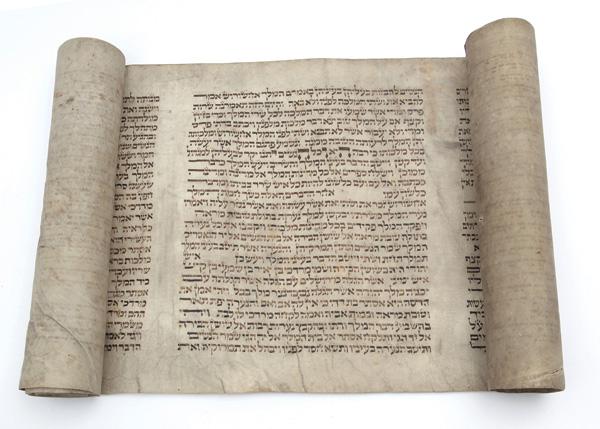
18-19c Polish Pale of Settlement Megillat Esther
A fifth acrostic appears at Esther 7:5, and its initial letters are likewise enlarged in the aforementioned tradition. This one spells out EHYH, alluding to ehyeh asher ehyeh (Shemot 3:14), using the final letter of each of four consecutive words in natural order (i.e. right to left): מִ֣י] ה֥וּא זֶה֙ וְאֵֽי־זֶ֣ה [ה֔וּא]] ([who] is he and where is [he]...."). These words come from the mouth of King Achashverosh, a Gentile, but the acrostic is formed as though from a speech spoken by a Jew. As the following word ends with an aleph, it would be possible to form the acrostic left to right, so its right-to-left structure reflects that the king is an ally of the Jews at this point. Since Hebrew verbs convey "verbal aspect" (aktionsart, i.e. kind of action) as opposed to "verbal tense" (time of action), the most accurate rendering of this phrase would be something akin to: "I have always been, still am, and will always be whom I have always been."
(ה) וַיֹּ֙אמֶר֙ הַמֶּ֣לֶךְ אֲחַשְׁוֵר֔וֹשׁ וַיֹּ֖אמֶר לְאֶסְתֵּ֣ר הַמַּלְכָּ֑ה מִ֣י ה֥וּא זֶה֙ וְאֵֽי־זֶ֣ה ה֔וּא אֲשֶׁר־מְלָא֥וֹ לִבּ֖וֹ לַעֲשׂ֥וֹת כֵּֽן׃
(5) Thereupon King Ahasuerus demanded of Queen Esther, “Who is he and where is he who dared to do this?”

Illuminated Megillah from Austrian Poland, ca. 1750
https://collections.library.yale.edu/catalog/2006020
Sfat Emet warns that he who reads the Megillah backwards (out of sequence) does not fulfill his obligation; for the allusions to G‑d's Name will not have been read in proper sequence.
It is not just Hashem who appears hidden, however. Rabbi Hillel Rivlin of Shkov paints a portrait of Mashiach ben Yosef which could suggest that this messianic figure is also hidden within the book of Esther, and may, in fact, be Esther herself for that generation.
(לט) לט) ויכר יוסף את אחיו והם לא הכירוהו (בראשית מ״ב:ח׳) – וזוהי אחת מתכונותיו של יוסף ולא רק בדורו כי אם בכל דור ודור אשר הוא משיח בן יוסף מכיר את אחיו והם לא מכירים אותו, ומעשה שטן הוא המסתיר את תכונותיו של מב״י שאין מכינין בעקבות משיחא וגם מזלזלים בהם בעוה״ר. (ראה להלן סימן ק״ג). כי לולא זאת היה כבר קץ לצרותינו. ואילו ישראל מכירים את יוסף, היינו עקבות דבן יוסף משיחא שהם קבוץ גלויות וכו׳ היינו נגאלים כבר בגאולה שלמה.
(39) (Gen. 42:8) Yosef recognized his brothers, but they did not recognize him -- This is one of the traits of Yosef not only in his own generation, but in every generation, i.e., that Mashiach ben Yosef recognizes his brothers, but they do not recognize him. This is the work of Satan, who hides the characteristics of Mashiach ben Yosef so that the footsteps of the Mashiach are not recognized and are even belittled because of our many sins. (See below 103). Otherwise, our troubles would already have ended. Were Israel to recognize Yosef, that is, the footsteps of ben Yosef the Mashiach which is the ingathering of the exiles etc., then we would already have been redeemed with a complete redemption.
(ח) ח) אילת השחר (תהילים כ״ב:ב׳) – ושם אלי למה עזבתני. תפלת אסתר המלכה שהיתה משיב״י ראה להלן (סימן קמ״א). וע״ז אמרו חז״ל (ירושלמי ברכות) כך היא גאולתן של ישראל כאילת השחר וכל הענין על האתחלתא דגאולה שהוא ביעודו של מב״י ובסוד אילה שלוחה בטוריא דמב״י בחינת בכור שורו כביאור רבנו בחבקוק (פ׳ ב׳).
(8) (Ps. 22:1) “the first rays of light before the dawn” -- In this Psalm we find: “my God, why have you forsaken me, ” which was the prayer of Queen Esther who was from the line of Mashiach ben Yosef. See below (#141). Our Sages said (Yerushalmi: Brachot, ch. 1) that the redemption of Israel will come about like the first rays of light before the dawn. They were referring to the beginning of the Redemption, the mission of Mashiach ben Yosef. In connection with this, as an additional explanation of , they also noted and referred to the mystery of Jacob’s blessing of Naftali: [Gen. 49:21] “a hind let loose.” This is in the line of Mashiach ben Yosef, from the aspect of “the firstborn of his ox” [see 11] which is explained by the Gaon in his commentary on Habakkuk (Ch. 2).
Spelling Anomalies
(טז) לַיְּהוּדִ֕ים הָֽיְתָ֥ה אוֹרָ֖ה וְשִׂמְחָ֑ה וְשָׂשֹׂ֖ן וִיקָֽר׃
(16) The Jews enjoyed light and gladness, happiness and honor.
The Ben Ish Chai explains that ora of 8:16 is written with a seemingly superfluous hey because it means ohr H', the light of HASHEM.
Citing Rashi on Mishlei 1:8, Rav Tzaddok HaKohen insists that ora is written with a letter hey because the verse intends it to be feminine, since the Torah being described here is specifically Torah she’bal peh (“the Oral Torah”).
(א) שמע בני מוסר אביך. מה שנתן הקב"ה למשה בכתב ועל פה: (ב) אמך. אומתך כנסת ישראל כמו (יחזקאל י״ט:ב׳) מה אמך לביאה והם דברי סופרים שחדשו והוסיפו ועשו סייגים לתורה:
In this view, Esther 9:27 is understood as indicating that the Jews of Esther's Persia reaffirmed (accepted anew) the Oral Torah at this time.
(כז) קִיְּמ֣וּ (וקבל) [וְקִבְּל֣וּ] הַיְּהוּדִים֩ ׀ עֲלֵיהֶ֨ם ׀ וְעַל־זַרְעָ֜ם וְעַ֨ל כׇּל־הַנִּלְוִ֤ים עֲלֵיהֶם֙ וְלֹ֣א יַעֲב֔וֹר לִהְי֣וֹת עֹשִׂ֗ים אֵ֣ת שְׁנֵ֤י הַיָּמִים֙ הָאֵ֔לֶּה כִּכְתָבָ֖ם וְכִזְמַנָּ֑ם בְּכׇל־שָׁנָ֖ה וְשָׁנָֽה׃
(27) the Jews undertook and irrevocably obligated themselves and their descendants, and all who might join them, to observe these two days in the manner prescribed and at the proper time each year.
R’ Chaim Kanievsky writes that it is written incompletely because circumcision, which this represents, has an element of pain. He notes that sasson is spelled completely in the next verse (Esther 8:17) because we should strive to add to the joy of Purim as though nothing is missing, as the Halacha (Biur Halacha 695, dh “ad d’lo yada”) states explicitly regarding the custom to become inebriated on Purim.
(יז) וּבְכׇל־מְדִינָ֨ה וּמְדִינָ֜ה וּבְכׇל־עִ֣יר וָעִ֗יר מְקוֹם֙ אֲשֶׁ֨ר דְּבַר־הַמֶּ֤לֶךְ וְדָתוֹ֙ מַגִּ֔יעַ שִׂמְחָ֤ה וְשָׂשׂוֹן֙ לַיְּהוּדִ֔ים מִשְׁתֶּ֖ה וְי֣וֹם ט֑וֹב וְרַבִּ֞ים מֵֽעַמֵּ֤י הָאָ֙רֶץ֙ מִֽתְיַהֲדִ֔ים כִּֽי־נָפַ֥ל פַּֽחַד־הַיְּהוּדִ֖ים עֲלֵיהֶֽם׃
(17) And in every province and in every city, when the king’s command and decree arrived, there was gladness and joy among the Jews, a feast and a holiday. And many of the people of the land professed to be Jews, for the fear of the Jews had fallen upon them.
At 10:1, there is a variant spelling of the name Achashverosh.5 According to Lekach Tov, the verse spells Achashverosh’s name differently here to indicate the people’s displeasure in being taxed. As the Talmud (Megilla 11a) notes, there is a vey (as in “oy vey”) in Achashverosh’s name because having to pay the extra money gave his citizens headaches.
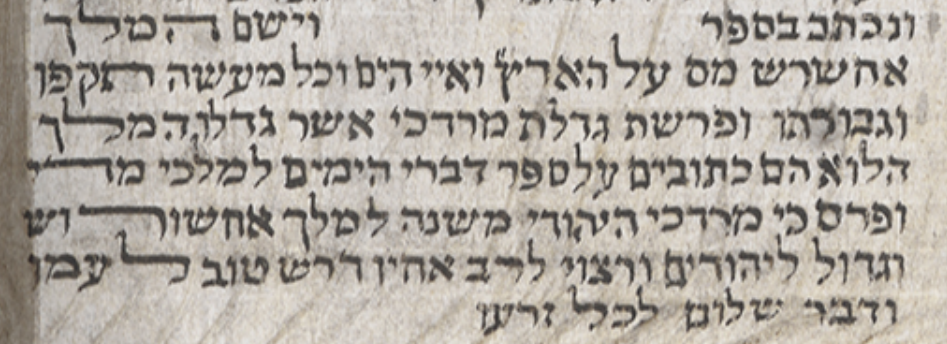
(א) וַיָּ֩שֶׂם֩ הַמֶּ֨לֶךְ (אחשרש) [אֲחַשְׁוֵר֧וֹשׁ] ׀ מַ֛ס עַל־הָאָ֖רֶץ וְאִיֵּ֥י הַיָּֽם׃
(1) King Ahasuerus imposed tribute on the mainland and the islands.
״אֲחַשְׁוֵרוֹשׁ״, אָמַר רַב: אָחִיו שֶׁל רֹאשׁ, וּבֶן גִּילוֹ שֶׁל רֹאשׁ. אָחִיו שֶׁל רֹאשׁ, אָחִיו שֶׁל נְבוּכַדְנֶצַּר הָרָשָׁע שֶׁנִּקְרָא ״רֹאשׁ״, שֶׁנֶּאֱמַר: ״אַנְתְּ הוּא רֵישָׁא דִּי דַהֲבָא״. בֶּן גִּילוֹ שֶׁל רֹאשׁ, הוּא הָרַג — הוּא בִּיקֵּשׁ לַהֲרוֹג, הוּא הֶחְרִיב — הוּא בִּיקֵּשׁ לְהַחְרִיב, שֶׁנֶּאֱמַר: ״וּבְמַלְכוּת אֲחַשְׁוֵרוֹשׁ בִּתְחִלַּת מַלְכוּתוֹ כָּתְבוּ שִׂטְנָה עַל יוֹשְׁבֵי יְהוּדָה וִירוּשָׁלִָם״. וּשְׁמוּאֵל אָמַר: שֶׁהוּשְׁחֲרוּ פְּנֵיהֶם שֶׁל יִשְׂרָאֵל בְּיָמָיו כְּשׁוּלֵי קְדֵרָה. וְרַבִּי יוֹחָנָן אָמַר: כֹּל שֶׁזּוֹכְרוֹ אֹמֵר ״אָח לְרֹאשׁוֹ״. וְרַבִּי חֲנִינָא אָמַר: שֶׁהַכֹּל נַעֲשׂוּ רָשִׁין בְּיָמָיו, שֶׁנֶּאֱמַר: ״וַיָּשֶׂם הַמֶּלֶךְ אֲחַשְׁוֵרוֹשׁ מַס״.
The Gemara continues with its explanation of the book of Esther, beginning with a discussion of the name Ahasuerus. Rav said: The name should be viewed as a contraction: The brother of the head [aḥiv shel rosh] and of the same character as the head [ben gilo shel rosh]. Rav explains: The brother of the head, i.e., the brother of the wicked Nebuchadnezzar, who is called “head,” as it is stated: “You are the head of gold” (Daniel 2:38). Of the same character as the head, for he, Nebuchadnezzar, killed the Jews, and he, Ahasuerus, sought to kill them. He destroyed the Temple, and he sought to destroy the foundations for the Temple laid by Zerubbabel, as it is stated: “And in the reign of Ahasuerus, in the beginning of his reign, they wrote to him an accusation against the inhabitants of Judah and Jerusalem” (Ezra 4:6), and he ordered that the construction of the Temple cease. And Shmuel said: The name Ahasuerus should be understood in the sense of black [shaḥor], as the face of the Jewish people was blackened in his days like the bottom of a pot. And Rabbi Yoḥanan said a different explanation: Everyone who recalled him said: “Woe upon his head” [aḥ lerosho]. And Rabbi Ḥanina said: The name alludes to the fact that everyone became poor [rash] in his days, as it is stated: “And the king Ahasuerus laid a tribute upon the land” (Esther 10:1).
The Aseret B'nei Haman
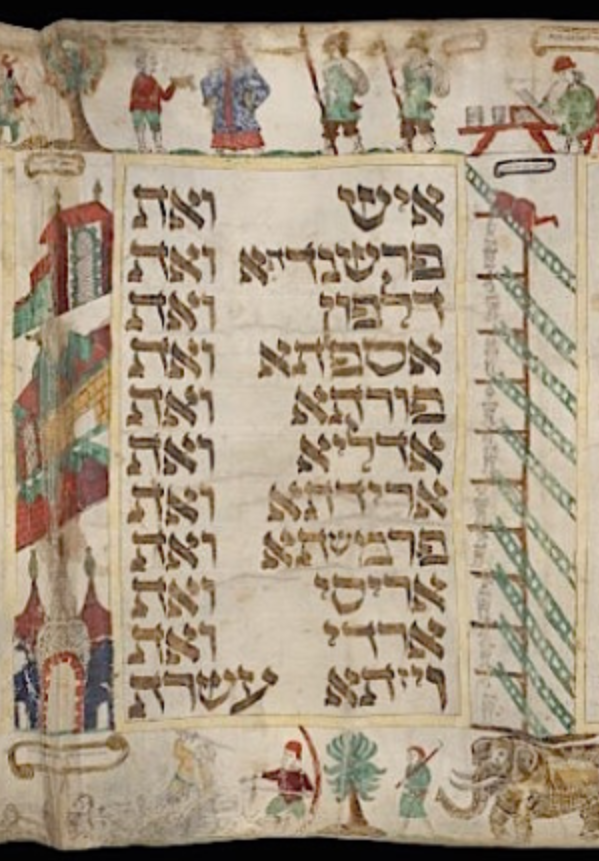
Dutch Megillah, ca. 1630 or 1640 (BL Or.1047)
It is a long-established tradition to write the list of Haman's hanged sons in two columns, i.e. half-brick over half-brick and brick over brick, to visually represent that the family of Haman, on account of their antisemitism, is in a chasm from which they may never find escape.
The vav of Vayzatha is generally written enlarged, as ordained in numerous scribal authorities.
(ה) עשרת בני המן מנהג מדינותינו לכתבם בדף מיוחד דהיינו בתחלת הדף איש בתחלת השיטה ואת בסוף השיטה וחלק באמצע. ואח"כ פרשנדתא מצד זה ואת מצד השני. וכן כולם. ובסוף הדף ויזתא מצד זה עשרת מצד השני. וצריכין להאריך בוי"ו דויזתא ויהי' ראשה כפוף קצת בזקיפה באלכסון למעלה כזה (ט"ז ופרמ"ג) (וי"א דיאריך בקריאתה):
It is the custom in these lands to write the ten sons of Haman on a special page, with “Ish” at the beginning of the top line and “Ve-et” at the end, with a space between, and then “Parshandata” at one side, “Ve-et” at the other, and so on, with “Vayzata” at one side of the last line and “Aseret” and the end. One must elongate the vav of “Vayzata,” and its head is bowed, but straightened a little so as to slant upwards (Or Zarua, Peri Megadim).
״וְאֵת פַּרְשַׁנְדָּתָא וְגוֹ׳ עֲשֶׂרֶת בְּנֵי הָמָן״. אָמַר רַב אַדָּא דְּמִן יָפוֹ: ״עֲשֶׂרֶת בְּנֵי הָמָן״ וַ״עֲשֶׂרֶת״ צָרִיךְ לְמֵמְרִינְהוּ בִּנְשִׁימָה אַחַת, מַאי טַעְמָא — כּוּלְּהוּ בַּהֲדֵי הֲדָדֵי נְפַקוּ נִשְׁמְתַיְיהוּ. אָמַר רַבִּי יוֹחָנָן: וָיו דְּ״וַיְזָתָא״ צָרִיךְ לְמִימְתְּחַהּ בִּזְקִיפָא כְּמוּרְדְּיָא דְלִבְרוּת. מַאי טַעְמָא — כּוּלְּהוּ בְּחַד זְקִיפָא אִזְדְּקִיפוּ. אָמַר רַבִּי חֲנִינָא בַּר פָּפָּא, דָּרֵשׁ רַבִּי שֵׁילָא אִישׁ כְּפַר תְּמַרְתָּא: כׇּל הַשִּׁירוֹת כּוּלָּן נִכְתָּבוֹת אָרִיחַ עַל גַּבֵּי לְבֵינָה וּלְבֵינָה עַל גַּבֵּי אָרִיחַ — חוּץ מִשִּׁירָה זוֹ וּמַלְכֵי כְנַעַן, שֶׁאָרִיחַ עַל גַּבֵּי אָרִיחַ וּלְבֵינָה עַל גַּבֵּי לְבֵינָה. מַאי טַעְמָא — שֶׁלֹּא תְּהֵא תְּקוּמָה לְמַפַּלְתָּן.
The verse states: “And in Shushan the capital the Jews slew and destroyed five hundred men. And Parshandatha…and Vaizatha, the ten sons of Haman” (Esther 9:6-10). Rav Adda from Jaffa said: When reading the Megilla, the names of the ten sons of Haman and the word “ten” must be said in one breath. What is the reason for this? It is that their souls all departed together. Rabbi Yoḥanan said: The letter vav in the name “Vaizatha” is a lengthened vav and must be elongated as a pole, like a steering oar of a ship [liberot]. What is the reason for this? To indicate that they were all hanged on one pole. Rabbi Ḥanina bar Pappa said that Rabbi Sheila, a man of the village of Timarta, interpreted a verse homiletically: All of the songs in the Bible are written in the form of a half brick arranged upon a whole brick and a whole brick arranged upon a half brick, i.e., each line of the song is divided into a stitch of text, referred to as a half brick, which is separated by a blank space, referred to as a whole brick, from the concluding stitch of that line of text. The next line of the song inverts the sequence. This is the principle for all songs in the Bible except for this song, referring to the list of Haman’s sons, and the song listing the kings of Canaan who were defeated by Joshua. These two songs are written in the form of a half brick arranged upon a half brick and a whole brick arranged upon a whole brick, i.e., one stitch of text over another, and one blank space over another. What is the reason that these two songs are written in this anomalous fashion? So that they should never rise from their downfall. Just as a wall that is built in this manner will not stand, so too, these individuals should have no resurgence.
R’ Moshe David Valle adds that Vayizatha was chosen to bear the enlarged vav because his hatred for the Jews was the greatest among the ten brothers.6
The three suspended letters in this passage have traditionally been understood to be highlighting their numerical values, and the enlarged waw as indicating the 6th Millennium. Thus, they seem to be pointing to a particular year on the Biblical Calendar.
- ת = 400
- 300 = ש
- 7 = ז
- 6th Millennium = ו
Their sum indicates Creation Year 5707, which runs from September 1946 to September 1947. On October 1, 1946 (which falls within that Biblical Year during the feast of Sukkot), a trial took place in Nuremberg, Germany in which twelve Nazi leaders were sentenced to death by hanging. One of the twelve, Hermann Goering, committed suicide in advance of the scheduled hanging, and another, Martin Bormann, was tried in absentia and was not in custody for the hanging, leaving ten to be put to death on the assigned date, i.e. October 16th of that same year. [1] One of the ten, Julius Streicher, uttered his final words on the way to the gallows: “Purim Fest ein tausend neun hundert sex-und-vierzig” (Festival of Purim, 1946), seemingly recognizing that the hanging of himself and his nine comrades was a second fulfillment of judgment against Israel’s enemies.

Midrash Rebbe Akiva ben Yosef al Otion Ketanot writes that the small letter zayin in Vayizatha hints to the seven negative characteristics which Haman ascribed to the Jews (Esther 3:8):
- am echad – they are singular
- mifuzar – they are spread apart
- mifurad – they are splintered among themselves
- bichol midinot – they are everywhere
- vi’dateihem shonot– their laws are different from ours
- datei hamelech einamotim – they ignore your law
- ein shoveh li’hanicham – they are not worth keeping
HaMelekh Format
The tradition of formatting the megillah so that המלך heads nearly every column (as below) does not seem to exist in the medieval period. It is a fairly infrequent one prior to the modern era,7 but has come to be the standard sofrut practice in current Ashkenaz and Sephardic practice. As the word occurs 192 times in the span of 10 chapters, it is not a difficult task. In order to accomplish this, these megillot tend to be written in 21 or 28 lines.
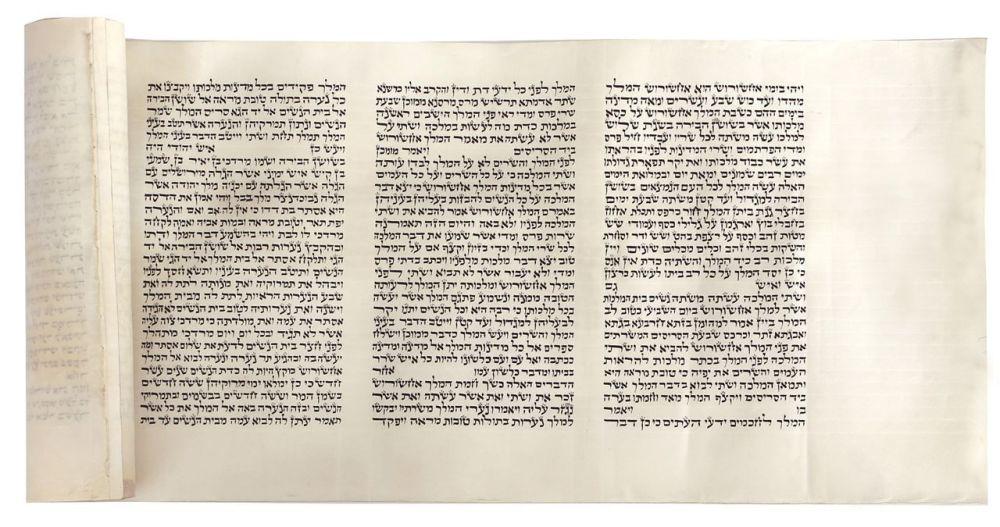
It is not uncommon to find the column-head instances of המלך adorned with a sketched crown or, alternatively, with embellished tagin on the lameds.


Yemenite Jews favor non-Hamelech megillot, as they hold to a tradition of heading every column with a new passuk (verse) so the Baal Koreh will not have to stop in the middle of the passage when moving to the next column. It can be seen in the image below that Rambam/Rosh paragraphing is also employed in Yemenite megillot.
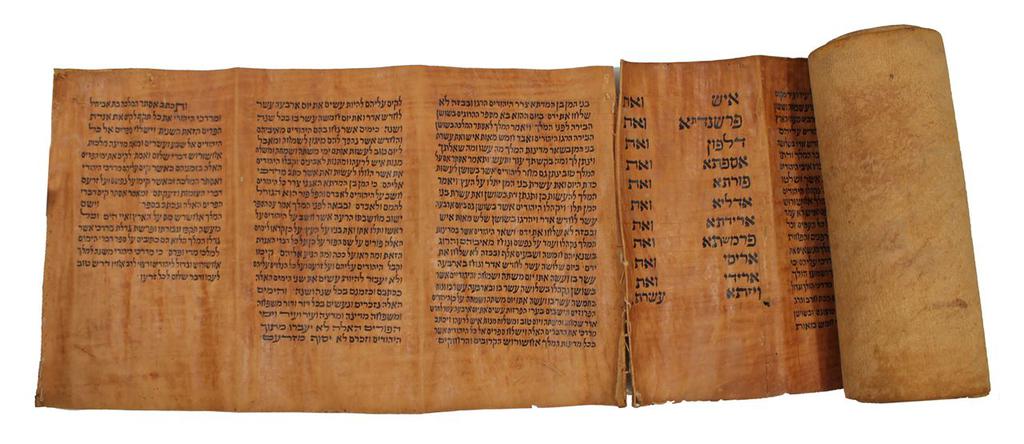
Paragraph Format
As with Yemenite exemplars, older Sephardic and Ashkenaz megillot employ Rambam/Rosh paragraphing, i.e. 11 open (petuchah) and 12 closed (setumah) paragraphs. The modern practice, however, is for every paragraph to be written setumah.
(ד) עושין כל פרשיותיה סתומות ואם עשאן פתוחות פסולה ויש מכשירין:
All the paragraphs are setumah, and it is invalid if any of them are made petuḥah, although some say it is valid.
The First and Last Letters
The Rokeach notes that the first and last letters of Megillat Esther are both vav, giving the total gematria 12. This, he suggests, alludes to the twelfth year of Achshverosh’s reign, when the Purim miracle occurred (Esther 3:17); the month of Adar, which is the twelfth month of the Jewish year; and the miracle occurring for the 12 tribes though Mordechai who came from Benyamin, the twelfth son of Yaakov. There is no special embellishment on either of these vavim in any known tradition.
Esther and Haman
Rokeach also observed that the names Esther and Haman each occur the same number of times in the megillah, i.e. 54 times apiece. The reason for this, he surmises, is to convey that the world was created with light and darkness present in perfect balance. This is seen as a picture of the free will to which every player in the account has equal access (as do we all).
The Longest Verse in the Tanakh
The longest verse in the Tanakh, with 192 letters and 43 words (these numbers don't seem to be significant), is found in Megillat Esther (8:9, below). The verse is pivotal to the message of the megillah in that it communicates the transmission of the edict through which the Jews of Persia were spared from extermination. The edict in view here is the counterpoint to the prior edict given at 3:12 and is similar in format. A question which the verse helps answer is this: "When Hashem's Covenant people are not where they are supposed to be (if this occurs after the Cyrus Decree allowing the Jews to return to Israel, yet these Jews remain in Persia), is He still with them?" The answer is an astounding "Yes, and He remains absolutely faithful to His Covenant!"
(9) So the king’s scribes were summoned at that time, on the twenty-third day of the third month, that is, the month of Sivan; and letters were written, at Mordecai’s dictation, to the Jews and to the satraps, the governors and the officials of the one hundred and twenty-seven provinces from India [Hodu] to Nubia [Kush]: to every province in its own script and to every people in its own language, and to the Jews in their own script and language.
(א) וַיְהִי בִּימֵי אֲחַשְׁוֵרוֹשׁ. מֶלֶךְ פָּרַס הָיָה, שֶׁמָּלַךְ תַּחַת כּוֹרֶשׁ לְסוֹף שִׁבְעִים שָׁנָה שֶׁל גָּלוּת בָּבֶל:
(1) It was in the days of Achashveirosh. He was the king of Persia who reigned in place of [i.e. after] Koresh at the end of the seventy years of the Babylonian exile.
If, however, the midrash regarding Esther being the mother of Koresh (Cyrus) is to be regarded as correct, something else is being conveyed here. That would be, possibly, that Esther is where she is "for such a time as this" in order to become the mother of a mashiach (Yeshayahu 45:1 calls Koresh by this title) in addition to being the mashiach ben Yosef (redeemer) of her own generation.
(א) כֹּֽה־אָמַ֣ר יְהֹוָה֮ לִמְשִׁיחוֹ֮ לְכ֣וֹרֶשׁ אֲשֶׁר־הֶחֱזַ֣קְתִּי בִֽימִינ֗וֹ לְרַד־לְפָנָיו֙ גּוֹיִ֔ם וּמׇתְנֵ֥י מְלָכִ֖ים אֲפַתֵּ֑חַ לִפְתֹּ֤חַ לְפָנָיו֙ דְּלָתַ֔יִם וּשְׁעָרִ֖ים לֹ֥א יִסָּגֵֽרוּ׃
(1) Thus said the LORD to Cyrus, His anointed one [Koresh, His Mashiach] —whose right hand He has-a grasped, treading down nations before him, ungirding the loins of kings,-b opening doors before him and letting no gate stay shut:
אָמַר רַבִּי יְהוּדָה בְּרַבִּי סִימוֹן דָּרְיָוֶשׁ הָאַחֲרוֹן בְּנָהּ שֶׁל אֶסְתֵּר הָיָה, טָהוֹר מֵאִמּוֹ וְטָמֵא מֵאָבִיו.
Said R. Yehuda son of R. Simon, "Darius the Last [i.e. Cyrus] was the son of Esther, pure from his mother and impure from his father."
וְעוֹד: מִי דָּמֵי? הָתָם כּוֹרֶשׁ, הָכָא דָּרְיָוֶשׁ! תָּנָא: הוּא כּוֹרֶשׁ, הוּא דָּרְיָוֶשׁ, הוּא אַרְתַּחְשַׁסְתְּא. כּוֹרֶשׁ — שֶׁמֶּלֶךְ כָּשֵׁר הָיָה, אַרְתַּחְשַׁסְתְּא — עַל שֵׁם מַלְכוּתוֹ, וּמָה שְׁמוֹ — דָּרְיָוֶשׁ שְׁמוֹ.
And further, a second objection: Are Rav Yosef’s objection and Rabbi Abbahu’s resolution comparable? There, Rabbi Abbahu speaks of Cyrus, whereas here, the verses speak of Darius, and it was never said about Darius that he was a virtuous king. The Gemara explains: This is not difficult, as the Sages taught in a baraita: All three names are referring to the same person: He is Cyrus; he is Darius; and he is also Artaxerxes. He was called Cyrus [Koresh] because he was a virtuous [kasher] king; he was called Artaxerxes after his kingdom, i.e., this was his royal title; and what was his real name? Darius was his name.
שנת עשרים לארתחשסתא המלך יין לפניו. פשטיה דקרא משמע דהאי עובדא דנחמיה בפני ארתחשסתא המלך היה דהוא ו דאמר מניסן מנינן למלכי ישראל א"כ קשו קראי אהדדי הוה ליה לאקשויי מהאי קרא גופיה דשנת עשרים לחדש תשרי קא חשיב וצריך לפרש דהכי דריוש בן אסתר שנבנה הבית בימיו אבל אי אפשר לומר כן דהא בשנת שיתא למלכות דריוש נבנה הבית כדכתיב ושיציא ביתא דנא ובסמוך מייתי לה והך עובדא דהכא בשנת עשרים הוה [דכבר היו ישראל בהשקט ובבטחה] ועוד דבסמוך פריך רב יוסף לר' אבהקאמר קרא שנת עשרים לארתחשסתא דהוא כורש ראשון של פקידת המלך דריוש הביא יין לפניו דהוא דריוש בן אסתר ומעשה הזה בשנה שלישית למלכותו כדכתיב (עזרא ד׳:כ״ד) באדין בטלת עבידת בית אלהא וגו' עד שנת תרתין לדריוש מלך פרס ובשנת שלש למלכו דבר נחמיה לפני המלך על חומת ירושלים המפורצת כדכתיב בעזרא והיא היתה שנת עשרים לכורש הראשון כדאי' במגילה פרק קמא (דף יא:) תלת דכורש וארביסר דאחשורוש ושתים דדריוש בן אסתר ובשלישית בקש נחמיה על בנין העיר ומיהו יש לפרש דקרא כפשטיה דבשנת שתים לדריוש התחילו לבנות הבית ונגמר הבנין בשנת שש למלכותו ולא בנו חומת העיר ושעריה כי אם בנין בית המקדש לבדו והיו נתונים ברעה גדולה ובחרפה לפי שהעכו"ם שוללים אותם עד שנת עשרים לדריוש שבקש על חומת העיר עד שעלתה ארוכה לחומת ירושלים כדמוכחי קראי אך בבנין הבית לא נתעסקו שכבר היו בנוי:
ברייתא ר׳ אליעזר בן יעקב אומר כל הנותן שלום לרבו חייב מיתה, ר׳ אליעזר בן דהבאי אומר כל הנותן שלום לרבו והמחזיר שלום לרבו והאומר דבר שלא שמע מפי רבו והחולק על ישיבתו של רבו גורם לשכינה שתסתלק מישראל וכל האומר דבר בשם רבו מביא גאולה לעולם שנא׳ ותאמר אסתר למלך בשם מרדכי:
[גמ׳] ת״ר כיצד יכול מרדכי להגיד לאסתר מלמד שנפתחו לו כלם ונכנס לפנים והגיד לה כל הסימנים והלא דברים ק״ו מה בנה של אסתר כתיב אני לפניך אלך והדורים אישר דלתות נחושה אשבר ובריחי ברזל אגדע מרדכי שהוא מזקני סנהדרין עאכ״ו:
BARAITHA. R. Eliezer b. Jacob said: Whoever greets his teacher [with the ordinary salutation] forfeits his life. R. Eliezer b. Dahabai said: Whoever greets his teacher [with the ordinary salutation], whoever responds to his salutation [in the ordinary way], whoever makes a statement [in the name of his teacher which] he has not heard from his mouth, and whoever opposes his School causes the Divine Presence to depart from Israel. But whoever repeats a statement in the name of his teacher brings redemption to the world; as it is stated, And Esther told the king in Mordecai’s name.
GEMARA. Our Rabbis taught: How could Mordecai have told Esther? It teaches that all [the gates] opened themselves for him and he entered within [the palace] and told her all the signs. This can be inferred by an argument from the less to the great: if it is written of the son of Esther ["the last Darius," i.e. Cyrus], I will go before thee, and make the crooked places straight; I will break in pieces the doors of brass, how much more so Mordecai, one of the Elders of the Sanhedrin!
The Longest Word in the Tanakh
The longest word in the megillah is tied with two other 11-letter words for longest length. This word, however, is unique in that it is not of Hebrew origin. It is a loanword from Old Persian, transliterated from xšaçapāvan (𐎧𐏁𐏂𐎱𐎠𐎺𐎠, literally "protector of the province"). It occurs at Esther 9:3. The other two are both found in Ezekiel — וּכְתוֹעֲבוֹתֵיהֶ֖ן (Ezekiel 16:47), “and their abominations,” and וְכַעֲלִילוֹתֵיכֶ֤ם (Ezekiel 20:44), translated as “and their doings.”
(ג) וְכׇל־שָׂרֵ֨י הַמְּדִינ֜וֹת וְהָאֲחַשְׁדַּרְפְּנִ֣ים וְהַפַּח֗וֹת וְעֹשֵׂ֤י הַמְּלָאכָה֙ אֲשֶׁ֣ר לַמֶּ֔לֶךְ מְנַשְּׂאִ֖ים אֶת־הַיְּהוּדִ֑ים כִּֽי־נָפַ֥ל פַּֽחַד־מׇרְדֳּכַ֖י עֲלֵיהֶֽם׃
(3) Indeed, all the officials of the provinces — the satraps, the governors, and the king’s stewards — showed deference to the Jews, because the fear of Mordecai had fallen upon them.
Physical Qualities of the Megillah
The Ink and the Parchment
With regard to the ink and parchment, the Maran Beit Yosef (R' Yosef Karo) cited specific requirements for the megillah.
(א) דיני כתיבת המגילה ותפירתה ובו יא סעיפים
אין כותבין המגילה אלא בדיו על הגויל או על הקלף כספר תורה ואם כתבה במי עפצים וקנקנתום כשרה כתבה בשאר מיני צבעונים פסולה וצריכה שירטוט כתורה עצמה ואין העור שלה צריך לעבד לשמה ויש אומרים שצריך עיבוד לשמה:
(ב) היתה כתובה על הנייר או על עור שאינו מעובד או שכתבה עכו"ם או אפיקורוס פסולה ודינה כספר תורה לענין היקף גויל וחטוטרות חתי"ן ותליית ההי"ן וקופי"ן וכל גופות האותיו' בצורתן ובחסרו' ויתרו': הגה גם צריך לכתבה מן הכתב (ר"ן) ולהוציא כל תיבה מפיו קודם שיכתבנה כמו בספר תורה [מהרי"ק] ועושין כל פרשיותיה סתומות ואם עשאן פתוחות פסולה [הגהות מיימוני פ"ב ופסקי מהרא"י סי' צ"ג] ובדיעבד אין ליפסול מגילה משום חסירות ויתרות דלא גרע מהשמיט בה הסופר אותיות דכשרה [הגהות מיימוני פ"ב וא"ז] [כמו שנתבאר סי' תר"ץ סעיף ג'] וצריכה עמוד בסופה וחלק בראשה כדי להקיפה בו ויש אומרים שצריכה תגין ויש אומרים שאינה צריכה: הגה ונהגו לתייגה גם נהגו שלא לעשות לה עמוד כלל בסופה [מהרי"ל]:
(ג) עשרת בני המן צריך לכתבם כשירה ולא כשאר שירו' שחלק על גבי כתב אלא מניח חלק בין כתב לכתב ואם לא עשה כן פסולה:
(ד) צריך להאריך בוא"ו דויזתא [בכתיבתה וי"א בקריאתה] [ר"ן בשם הרא"ש ומהרי"ל וב"י בשם א"ח] וצריך לכתוב איש בראש דפא ואת בסופה:
(1) We may only write a Scroll with ink on a hide or on a parchment, like a Torah [scroll]. But if one wrote it with gallnut extract and iron sulfate, it is [also] fit. If he wrote it with other types of dyes, it is disqualified. And it requires scoring like a Torah itself. But its leather does not require processing for the sake of [the commandment]. And some say it (the leather) that it requires processing for the sake of [the commandment]...
(2) [If] it was written on paper or on hide that was not processed or was written by an idolater or a heretic, it is disqualified.
(4) If it [the Megillah] was sown with linen thread it is disqualified
The Eytz Chayim
Sephardic megillot must have an eytz chayim affixed in order to be considered kosher lechatchilla, but may be considered kosher b'dieved without one (Chazon Ovadiah on Purim, pg. 243). The general practice among older Ashkenazic megillot is to affix an eytz chayim at the end of the megillah only, as opposed to one at each end as with a Sefer Torah. The Rema opined that it is improper to affix an eytz chayim to the end of a megillah, insisting “nahagu shelo laasos lah amud klal b’sofah”, that our minhag is specifically not to have any amud at all at the end of the megillah (Orach Chaim 691:2). Modern Ashkenaz megillot, per R' Shlomo Ganzfried, are not to have eytzim chayimim attached.
(ג) צריכין להניח בתחלה קלף חלק שיעור כדי להקיפה. ונוהגין שלא לעשות לה עמוד כלל לא בתחלה ולא בסופה:
One must leave enough blank klaf at the beginning to wrap around the roll. The custom is not to put it on an amud (stave) at either the beginning or the end.
Liturgical Elements
Sephardic Preamble to the Megillah Reading
Sephardic megillot generally have rolled up with them on a loose sheet of parchment a liturgical preamble which is read prior to the obligatory Purim readings. It is a "string of pearls" liturgy called Hasdei comprised of several verses from the Tanakh in sequence with some liturgical bridges interspersed. This is generally written only in Hebrew and can be written with or without nikkudot. Divine names should be circumscribed and it is not uncommon to use aleph-lamed ligatures, as below.
ז חַסְדֵי ה׳ אַזְכִּיר תְּהִלֹּת ה׳ כְּעַל כֹּל אֲשֶׁר גְּמָלָנוּ ה׳ וְרַב טוּב לְבֵית יִשְׂרָﭏ אֲשֶׁר גְּמָלָם כְּרַחֲמָיו וּכְרֹב חֲסָדָיו. ח וַיֹּאמֶר אַךְ עַמִּי הֵמָּה בָּנִים לֹא יְשַׁקֵּרוּ וַיְהִי לָהֶם לְמוֹשִׁיעַ. ט בְּכָל צָרָתָם לא [לוֹ] צָר וּמַלְאַךְ פָּנָיו הוֹשִׁיעָם בְּאַהֲבָתוֹ וּבְחֶמְלָתוֹ הוּא גְאָלָם וַיְנַטְּלֵם וַיְנַשְּׂאֵם כָּל יְמֵי עוֹלָם.
(7) I will recount the kind acts of the HASHEM, the praises of the HASHEM — for all that the HASHEM has wrought for us, the vast bounty to the House of Israel that He bestowed upon them according to His mercy and His great kindness. (8) He thought: Surely they are My people, children who will not play false. So He was their Deliverer. (9) In all their troubles He was troubled, and the angel of His Presence delivered them. In His love and pity He Himself redeemed them, raised them, and exalted them all the days of old.
(כב) חַסְדֵי ה׳ כִּי לֹא תָמְנוּ כִּי לֹא כָלוּ רַחֲמָיו.
(22) The kindness of the HASHEM has not ended, His mercies are not spent.
(ו) וּבְמַלְכוּת אֲחַשְׁוֵרוֹשׁ בִּתְחִלַּת מַלְכוּתוֹ כָּתְבוּ שִׂטְנָה עַל יֹשְׁבֵי יְהוּדָה וִירוּשָׁלִָם.
זֶרַע עֲמָלֵק הָרָשָע חָשַב עַל הַיְּהוּדִים לְאַבְּדָם וְהִפִּיל פּוּר הוּא הַגּוֹרָל לְהֻמָּם וּלְאַבְּדָם:
The seed of the wicked Amalek thought the Jews to be lost and the downfall of the lot is the fate for them — to be destroyed and to be lost.
רָאָה ﭏהִים אֵת אֲשֶׁר זָמַם וַיֵּרַע בְּעֵינָיו:
G-d has taken away their happiness, and he has done evil in his sight.
הָפַך עָלָיו אֶת גּוֹרָלוֹ הֵפֵר עֲצָתוֹ וַיָּשֶב לוֹ גְּמוּלוֹ בְּרֹאשׁוֹ:
He overthrew his fate, spurning his counsel and having his reward resting on his head.
הִצִּיל עַמּוֹ מִיַּד אוֹיְבֵיהֶם מִּכַּף רְשָׁעִים פָּדָה אוֹתָם:
He delivered them out of the hand of their enemies; out of the palm of the wicked He redeemed them.
(יד) לֹא הִנִּיחַ אָדָם לְעָשְׁקָם וַיּוֹכַח עֲלֵיהֶם מְלָכִים.
He reproved kings on their account,
(כב) כִּי לֹא יִטֹּשׁ ה׳ אֶת עַמּוֹ בַּעֲבוּר שְׁמוֹ הַגָּדוֹל כִּי הוֹאִיל ה׳ לַעֲשׂוֹת אֶתְכֶם לוֹ לְעָם.
(22) For the sake of His great name, HASHEM will never abandon His people, seeing that HASHEM undertook to make you His people.
(8) How can I give you up, O Ephraim? How surrender you, O Israel? How can I make you like Admah, render you like Zeboiim? I have had a change of heart, all My tenderness is stirred. (9) I will not act on My wrath, will not turn to destroy Ephraim. For I am G-d, not man, the Holy One in your midst: I will not come in fury.-f
(ח) הִנֵּה עֵינֵי אֲדֹנָי ה׳ בַּמַּמְלָכָה הַחַטָּאָה וְהִשְׁמַדְתִּי אֹתָהּ מֵעַל פְּנֵי הָאֲדָמָה אֶפֶס כִּי לֹא הַשְׁמֵיד אַשְׁמִיד אֶת בֵּית יַעֲקֹב נְאֻם ה׳.
(8) Behold, the Lord HASHEM has His eye upon the sinful kingdom: I will wipe it off the face of the earth! But, I will not wholly wipe out the House of Jacob — declares HASHEM.
(יג) כְּרַחֵם אָב עַל בָּנִים רִחַם ה׳ עַל יְרֵאָיו.
(13) As a father has compassion for his children, so HASHEM has compassion for those who fear Him.
גָּבְרוּ חֲסָדָיו עָלֵינוּ וְלֹא כָלוּ רַחֲמָיו מִמֶּנּוּ:
His righteousness prevailed over us, but His mercy was not with us.
זָכַר בְּרִיתוֹ אִתָּנוּ עַל יַד צִיר נֶאֱמָן הִבְטִיחָנוּ כַּכָּתוּב עַל יְדֵי מֹשֶׁה נְבִיאֵנוּ:
Remember His covenant with us by the hand of the faithful, we have been promised as written by Moshe our prophet:
(מד) וְאַף גַּם זֹאת בִּהְיוֹתָם בְּאֶרֶץ אֹיְבֵיהֶם לֹא מְאַסְתִּים וְלֹא גְעַלְתִּים לְכַלֹּתָם לְהָפֵר בְּרִיתִי אִתָּם כִּי אֲנִי ה׳ ﭏהֵיהֶם.
(44) Yet, even then, when they are in the land of their enemies, I will not reject them or spurn them so as to destroy them, annulling My covenant with them: for I, HASHEM, am their God.
לְעוֹלָם אֶזְכּוֹר לָהֶם חַסְדִּי וּבְרִיתִי נֶאֱמֶנֶת לָהֶם וְלֹא אֲשַׁקֵּר בֶּאֱמוּנָתִי:
I will always remember them, for my lovingkindness and my covenant are faithful unto them, and I will not lie in my faithfulness.
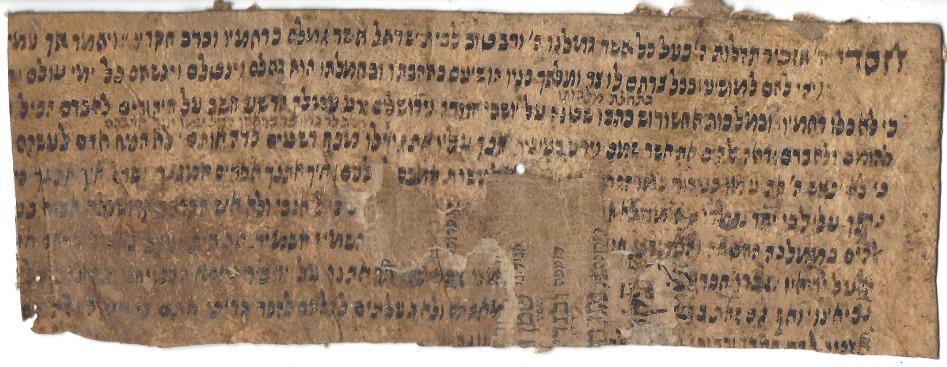
a near-complete preamble sheet found in a bookbinding genizah
Manuscript Research Group, Spring Lake, Michigan
Blessings Before the Reading of the Megillah
The following blessing are sometimes included in the scroll itself, on a protocol panel. This is purely optional. If included, it should be written only in Hebrew, generally with Hashem circumscriptions and aleph-lamed ligatures, usually with nikkudot to differentiate it from the canonical text.
(א) קריאת המגילה
(ב) לפני קריאת המגילה מברך החזן בעמידה, וגם הקהל יעמדו בשעת הברכה ויכונו לצאת ידי חובת הברכה והקריאה:
(ג) בָּרוּךְ אַתָּה ה׳, ﭏהֵינוּ מֶלֶךְ הָעוֹלָם, אֲשֶׁר קִדְּשָׁנוּ בְּמִצְוֹתָיו, וְצִוָּנוּ עַל מִקְרָא מְגִלָּה:
(ד) בָּרוּךְ אַתָּה ה׳, ﭏהֵינוּ מֶלֶךְ הָעוֹלָם, שֶׁעָשָׂה נִסִּים לַאֲבוֹתֵינוּ בַּיָּמִים הָהֵם בַּזְּמַן הַזֶּה:
(ה) בליל פורים, מברך ברכת "שהחיינו". ביום הפורים גם יברך ויכווין לכלל מצוות היום, מקרא מגילה, משלוח מנות, משתה ושמחה, מתנות לאביונים.
(ו) בָּרוּךְ אַתָּה ה׳ ﭏהֵינוּ מֶלֶךְ הָעוֹלָם, שֶׁהֶחֱיָנוּ וְקִיְּמָנוּ וְהִגִּיעָנוּ לַזְּמַן הַזֶּה:
(1) The Reading of the Megillah
(2) Before the reading of the Megillah, the cantor blesses, standing, and the congregation also stands during the blessing and prepares to go about the duty of blessing and reading.
(3) Blessed are you, HASHEM our G-d, King of the universe, Who has sanctified by His commandments, and commanded us regarding the reading of the megillah.
(4) Blessed are you, HASHEM our G-d, King of the universe, Who performed miracles for our forefathers in those days in this season.
(5) On the eve of Purim, he recites the blessing 'Shehechiyeinu.' On the day of Purim, he also recites the blessing over all the mitzvot of the day: the sending of food, the feast and merriment, and gifts for the poor.
(6) Blessed are you, HASHEM our G-d, King of the universe, Who gave us life, sustained us, and enabled us to arrive at this season.
(יב) אָרוּר הָמָן, בָּרוּךְ מָרְדְּכַי.
(יג) אֲרוּרָה זֶרֶשׁ, בְּרוּכָה אֶסְתֵּר.
(יד) אֲרוּרִים כָּל־הָרְשָׁעִים, בְּרוּכִים כָּל־יִשְׂרָאֵל. וְגַם חַרְבוֹנָה זָכוּר לטוֹב:
(12) Cursed be Haman who sought to destroy me; blessed be Mordechai the Jew.
(13) Cursed be Zeresh, wife to the terrible; blessed be Esther who interceded on my behalf.
(14) Cursed be all the wicked; blessed be all the righteous. And may Charvonah also be remembered favorably.
Fulfillment of a Mitzvah
§ The mishna continues: If one was writing a Megillah, or expounding upon it, or correcting it, and he read all its words as he was doing so, if he had intent to fulfill his obligation with that reading he has fulfilled his obligation. The Gemara asks: What are the circumstances of this case? If he was articulating each verse of the Megillah and then writing it down, what of it that he intended to fulfill his obligation with that reading, since he recited those words by heart? Rather, it must be that he first wrote each verse in the Megillah and then read it out.

Notes
- Katrin Kogman-Appel, Jewish Manuscript Illumination (2014), introduction.
- Morris M. Faierstein, ed., Ze’enah u Re’enah (Berlin: Walter de Gruyter GmbH & Co, 2017), 1122.
-
Kitvei R' Moshe David Valle - Sefer HaYeshua al Megillat Esther (Italy, 18th century); online: https://www.torahmusings.com/wp-content/uploads/2020/03/Esther-third.pdf.
-
Note that Esther is a Persian name (possibly related to Ishtar), chosen as a pseudonym for Hadassah (Hebrew for myrtle), but the similarity to the Hebrew root סתר (to hide) is likely not accidental.
-
The name Achashverosh is Hebrew for what occurs in many English texts as Ahasuerus (Latin: Rex Assuerus) or Xerxes/Artaxerxes (Greek: Ἀρταξέρξης, approximating Artaxšaθra). All are quasi-transliterations of the Persian name Khshayārsha (خشایارشا).
-
Kitvei R' Moshe David Valle - Sefer HaYeshua al Megillat Esther (Italy, 18th century); online: https://www.torahmusings.com/wp-content/uploads/2020/03/Esther-third.pdf.
-
The NLI records 26 scrolls of Megillot haMelekh, beginning in the 18th century, including 16 before 1745.
